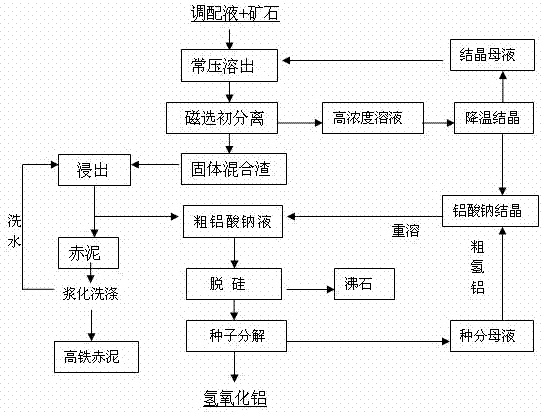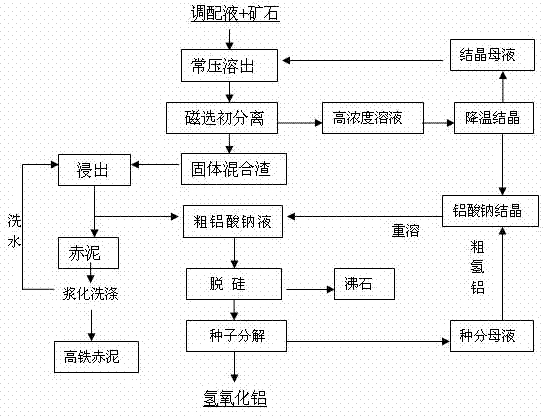Method for treating gibbsite by using high-concentration alkali liquor under normal pressure
A gibbsite ore and atmospheric pressure treatment technology, which is applied in the direction of alumina/hydroxide, etc., can solve the problems of high energy consumption, large amount of evaporated water of the mother liquor of seed separation, and difficulty in liquid-solid separation
- Summary
- Abstract
- Description
- Claims
- Application Information
AI Technical Summary
Problems solved by technology
Method used
Image
Examples
Embodiment 1
[0026] Take 550g of 40% sodium hydroxide solution and 300g of gibbsite ore with particle size≤106μm (the molecular ratio in the eluate is α K =5.18), stirring and mixing in the alkali-resistant reactor, heating to 140°C at the same time, and holding the heat for 30 minutes to make the components in the bauxite fully react with the lye to obtain a slurry containing sodium aluminate. Cool the dissolution slurry to about 100°C, and use a magnetic separation classifier for preliminary separation: the separated solid slag is added to 60°C water for leaching, and then further liquid-solid separation is obtained to obtain high-iron red mud, and the leachate enters the desiliconization process; after magnetic separation and separation The solution is seeded with solid sodium aluminate and crystallized by cooling to obtain Na 2 (Al 2 o 3 (OH) 2 )1.5H 2 O solid, the crystallization mother liquor returns to the stripping process to continue stripping bauxite trihydrate, and the sodiu...
Embodiment 2
[0033] In an alkali-resistant reactor, stir and mix 600g of 45% sodium hydroxide solution and 300g of gibbsite ore with a particle size of ≤150μm (the molecular ratio in the eluate is α K =5.64), stir the mixture in the reactor and heat it to 135°C, and keep it warm for 30 minutes to fully react the alumina and sodium hydroxide in the bauxite to obtain a slurry containing sodium aluminate. Lower the elution slurry to about 100°C, and use a magnetic separation classifier for preliminary separation: the separated solid slag is added to the washing water for leaching, and then further separated to obtain high-iron red mud, and the leaching solution enters the desiliconization process; the solution after magnetic separation and separation is used Solid sodium aluminate is used as seed crystal, after cooling and crystallization, the crystallization mother liquor returns to the dissolution process to continue to dissolve bauxite trihydrate, sodium aluminate crystallization is mixed w...
Embodiment 3
[0038] In an open steel reaction kettle, stir and mix 1000g of 39% sodium hydroxide solution and 500g of gibbsite ore with a particle size below 106μm (the molecular ratio in the eluate is α K =4.95), heated to 140°C in the reactor, added 20g of pure Ca(OH) 2 (molar ratio [CaO:SiO 2 ]=1.5), and stir for 20 minutes to fully react each component of bauxite with sodium hydroxide to obtain a slurry containing sodium aluminate. Reduce the slurry to about 100°C, and use a magnetic separation classifier for preliminary separation: the separated solid slag is added to 80°C water for leaching, and then further separated to obtain high-iron red mud, and the leachate enters the desiliconization process; the solution after magnetic separation is used Solid sodium aluminate is used as seed crystal, after cooling and crystallization, the crystallization mother liquor is returned to the dissolution process to continue to dissolve bauxite trihydrate, sodium aluminate crystallization is mixed...
PUM
| Property | Measurement | Unit |
|---|---|---|
| particle size | aaaaa | aaaaa |
| decomposition efficiency | aaaaa | aaaaa |
Abstract
Description
Claims
Application Information
 Login to View More
Login to View More - R&D Engineer
- R&D Manager
- IP Professional
- Industry Leading Data Capabilities
- Powerful AI technology
- Patent DNA Extraction
Browse by: Latest US Patents, China's latest patents, Technical Efficacy Thesaurus, Application Domain, Technology Topic, Popular Technical Reports.
© 2024 PatSnap. All rights reserved.Legal|Privacy policy|Modern Slavery Act Transparency Statement|Sitemap|About US| Contact US: help@patsnap.com










